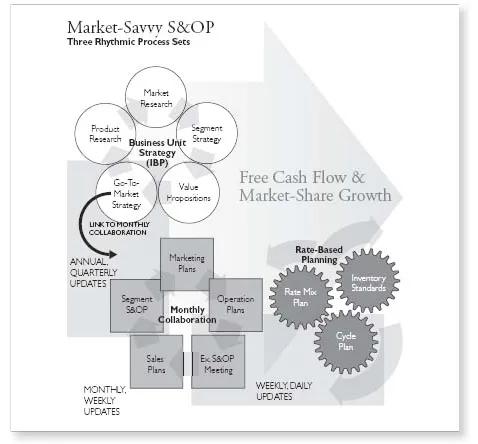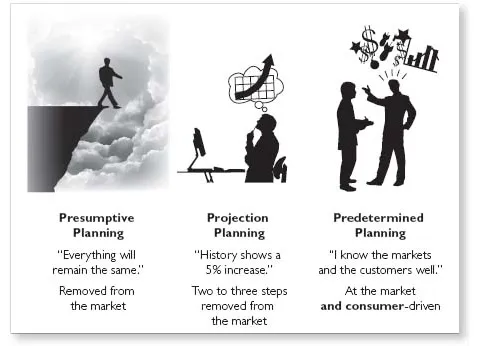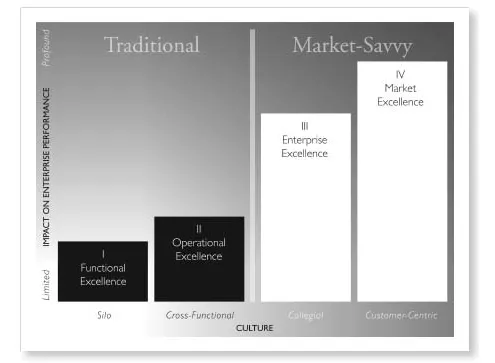CHAPTER 1
Seeing Anew from a Market-Savvy Perspective
In the new demand economy, a significant competitive differentiator is market savviness, which is another way of saying mastery of the marketplace. Companies prevailing competitively possess remarkable comprehension of their markets. They lead in understanding customers, demand, and competitors and in articulating a distinctive go-to-market strategy.
The marketplace actually distills this strategy, so the executive team no longer needs to rely on historical data for strategic planning. Plans come from observing signals about future trends, rather than seeking insights from the plans of predecessors or historical data about the past. This new approach is known as predetermined planning. Most companies currently rely on either a presumptive or a projection approach to planning: They presume their market position will remain unchallenged, or they project a modest, easy-to-achieve improvement. In predetermined planning, in contrast, the essence of planning is transformed from looking at history and internally developed strategies to discovering what has been determined about your products and segments by customers in the marketplace. The first guiding principle for designing market-savvy S&OP—market in—begins with this approach to planning. (See Figure 1-1.)
This predetermined planning perspective is the key to understanding the market-savvy approach to supply chain management. In the on-demand world, opportunities exist for those willing to discover market realities, gain marketplace mastery, and determine how to gain competitive advantage.
Planning is done best when there is clarity of both customers and competitors. When planning is done at a high level of aggregation such as for a whole profit center or, worse, for a group of profit centers at say a corporate level, different groups of customers are mixed together and a broad array of competitors are involved. The planning done in the market-savvy approach requires disaggregation down to the market segment level. We have found a value segmentation of the market works best.
Figure 1-1. PLANNING APPROACHES.
Predetermined planning is the essence of the “market-in” principle for market-savvy S&OP.
Value segmentation is a departure from traditional segmentation, describing markets in the providers’ terms, such as how much of your product they buy or where they are located. It determines how customers are grouped according to the values they hold most dear as well as how they generate cash. Value segmentation is achieved by research done by a cross-functional team of savvy professionals. The team approach seeks answers to the question, “How can we be of value to you?” Traditionally, the fieldwork is done by sales reps asking, “How much do you need, and how much will you pay?” This research seeks to broaden depth of knowledge about customers.
Value segmentation leads to the articulation of a go-to-market strategy. The go-to-market strategy by segment educates everyone in the organization about your overarching goal in each segment.
Market-Savvy S&OP Defined
Market-savvy S&OP is fundamentally different from traditional S&OP in profound ways. Most important is its customer focus and its impact on the performance of the enterprise. In market-savvy S&OP, the overarching goals are increasing market share and generating free cash flow (FCF). Both are goals of prime importance to senior management. In market-savvy S&OP, multiple teams are focused on achieving the goals for which the CEO is held accountable by the board of directors.
Four Levels of Maturity in S&OP
Market-savvy S&OP is the highest level of maturity in S&OP, as described in Figure 1-2. The market-savvy S&OP is the process used inside a market-driven supply chain.
In traditional S&OP, the goal is operational excellence, with a cross-functional culture in the internal organization. Traditional S&OP determines sales volume and identifies product mix requirements. The idea is to efficiently use manufacturing capacity.
FIGURE 1-2. FOUR LEVELS OF ADVANCEMENT IN S&OP.
The more advanced applications of S&OP generate far greater benefits than the entry levels.
Today, however, markets do not react to manufacturing efficiency alone; they require much more. Market-savvy S&OP changes the entire focus of the organization to the outside—to an “at-market” level—and brings those market insights in to start the planning processes. Specifically, it:
Strives for market excellence with a collegial and customer-centric culture transcending the internal organization to include customers and suppliers in the most intimate levels of planning and decision making, including product selection decisions and inventory strategies.
Is run at the major market segment level within a business unit—not one-size-fits-all, but tailored to customer needs.
Requires forecasting demand two steps closer to actual demand. Traditional S&OP forecasts demand at the manufacturer level and may plan inventory at the customer level (vendor-managed inventory, or VMI). Market-savvy S&OP forecasts consumer take-away from the customer.
Manages capacity to demand and manages production to demand through rate-based planning and flexible inventory standards, the replacement for material requirements planning (MRP), and safety stocks.
Closely aligns performance measures to senior management's objectives: free cash-flow generation and market share capture.
The demand-economy requirement is to move to a market-savvy S&OP process. It should not be confused with the well-known operationally focused S&OP process, shown at Level I of Figure 1-2, used by most companies for the past 20 to 25 years. Market-savvy S&OP is practiced in part by fewer than 5 percent of the most successful companies in the United States and by an even smaller percentage of the world's manufacturers. Precious few—in fact, we have not found any—practice the full complement of market-savvy S&OP processes.
The P in Market-Savvy S&OP
The P in S&OP, planning, is the predetermined approach to planning as illustrated in Figure 1-1. This type of planning requires a more rigorous investigation of how your products are being accepted or rejected and how your selected competitive approach stacks up in the real market. Predetermined means the market will have provided signals about what will be successful. For sure, some aspects of your plans may be more difficult to prove than others. In the predetermined approach, the cross-functional team must find leading indicators of the success or failure of planning alternatives. Leading indicators may be very knowledgeable individuals or leading indicator stores. Often, the best approach is to structure your go-to-market strategy with well-defined trigger points at which a disciplined assessment of your plans is completed before just forging ahead. At the beginning of each business cycle, normally once per year or season, decisions can be made based on how the market reacts to your offerings and your competitor's. The key is to be in the market and finding the signals.
It is essential to adopt a predetermined planning approach. Most planning processes have been built on the concept, historical data regarding the manufacturer's shipments well defines the future, and all one needs is a little care given to new products and possibly marketing programs and promotions. However, in the new demand economy, product and demand patterns change so rapidly, and market forces are so specialized and volatile, historical data at the manufacturer's level become stale very quickly. Predictive information—gathered two or more steps further down the demand network of manufacturers, wholesalers, retailers, and consumers—is required.
In the future, planning must be done very close to the consumer/customer to understand what is changing and by how much. Certainly, the basic demand driver of price points, combined with consumer/customer perceptions of quality, still applies, and product applications remain somewhat constant. But what changes are competitor offerings; the availability of products from different sources, including the Internet; the customer's desire to sell; and network inventory. Predetermined planning relies on a high level of interaction between cross-functional market-focused teams and consumers/customers, using knowledge to anticipate changes in demand.
IBP Provides the Strategy
As shown in our seminal diagram, Figure PI-1, business unit strategy is within market-savvy S&OP. The process is commonly known as integrated business planning, or IBP. There is a fair amount of confusion around the definition of IBP today, so it seems appropriate to offer some explanation and clarification regarding our viewpoint about it. We see IBP as a formal process in and of itself; it should not be mistaken for a more advanced form of the common monthly S&O...









